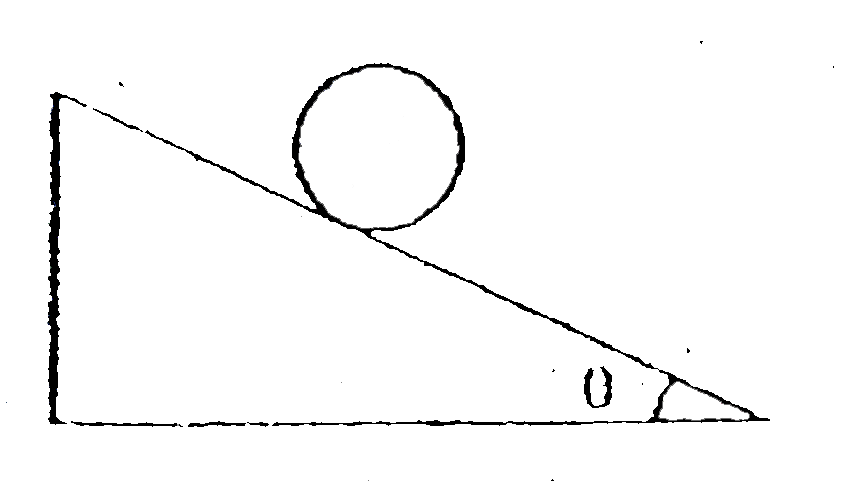A solid cylinder of mass M and radius R rolls down an inclined plane without slipping. THE speed of its centre of mass when it reaches the bottom is
√(2gh)
√4/3.gh
√3/4.gh
√(4g/h)
The correct Answer is:B
To find the speed of the center of mass of a solid cylinder rolling down an inclined plane without slipping, we can use the principle of conservation of energy. Here’s a step-by-step solution:
Step 1: Identify the initial and final energy states
- Initial State: At the top of the inclined plane, the cylinder has potential energy and no kinetic energy since it starts from rest.
- Final State: At the bottom of the inclined plane, the cylinder has both translational kinetic energy and rotational kinetic energy.
Step 2: Write the expression for potential energy at the top
The potential energy (PE) at the top of the incline can be expressed as:
PE=mgh
where m is the mass of the cylinder, g is the acceleration due to gravity, and h is the height of the inclined plane.
Step 3: Write the expression for kinetic energy at the bottom
At the bottom of the incline, the total kinetic energy (KE) consists of translational kinetic energy and rotational kinetic energy:
KE=12mv2+12Iω2
For a solid cylinder, the moment of inertia I is given by:
I=12mr2
Since the cylinder rolls without slipping, we have the relationship:
v=rω⇒ω=vr
Substituting ω into the kinetic energy expression:
KE=12mv2+12(12mr2)(vr)2
This simplifies to:
KE=12mv2+14mv2=34mv2
Step 4: Apply the conservation of energy principle
According to the conservation of energy, the potential energy at the top equals the total kinetic energy at the bottom:
mgh=34mv2
We can cancel m from both sides (assuming m≠0):
gh=34v2
Step 5: Solve for v
Rearranging the equation to solve for v2:
v2=4gh3
Taking the square root gives:
v=√4gh3
Final Result
Thus, the speed of the center of mass of the solid cylinder when it reaches the bottom of the inclined plane is:
v=2√3√gh
- Initial State: At the top of the inclined plane, the cylinder has potential energy and no kinetic energy since it starts from rest.
- Final State: At the bottom of the inclined plane, the cylinder has both translational kinetic energy and rotational kinetic energy.
The potential energy (PE) at the top of the incline can be expressed as:
PE=mgh
where m is the mass of the cylinder, g is the acceleration due to gravity, and h is the height of the inclined plane.
At the bottom of the incline, the total kinetic energy (KE) consists of translational kinetic energy and rotational kinetic energy:
KE=12mv2+12Iω2
For a solid cylinder, the moment of inertia I is given by:
I=12mr2
Since the cylinder rolls without slipping, we have the relationship:
v=rω⇒ω=vr
Substituting ω into the kinetic energy expression:
KE=12mv2+12(12mr2)(vr)2
This simplifies to:
KE=12mv2+14mv2=34mv2
According to the conservation of energy, the potential energy at the top equals the total kinetic energy at the bottom:
mgh=34mv2
We can cancel m from both sides (assuming m≠0):
gh=34v2
Rearranging the equation to solve for v2:
v2=4gh3
Taking the square root gives:
v=√4gh3
Thus, the speed of the center of mass of the solid cylinder when it reaches the bottom of the inclined plane is:
v=2√3√gh
Topper's Solved these Questions
- COMPETITION CARE UNITBOOK - ICSECHAPTER - COMPETITION CARE UNITEXERCISE - GRAVITATION
25 Videos
- COMPETITION CARE UNITBOOK - ICSECHAPTER - COMPETITION CARE UNITEXERCISE - PROPERTIES OF MATTER (ELASTICITY )
22 Videos
- COMPETITION CARE UNITBOOK - ICSECHAPTER - COMPETITION CARE UNITEXERCISE - UNIFORM CIRCULAR MOTION
25 Videos
- CIRCULAR MOTION BOOK - ICSECHAPTER - CIRCULAR MOTION EXERCISE - MODULE 2 (FROM ROTATIONAL KINETIC ENERGY , WORK ,POWER)
24 Videos
- DIMENSIONSBOOK - ICSECHAPTER - DIMENSIONSEXERCISE - SELECTED PROBLEMS (FROM CONVERSIONS OF ONE SYSTEMS OF UNITS INTO ANOTHER)
9 Videos
Similar Questions
A solid cylinder of mass M and radius R rolls down an inclined plane of height h without slipping. The speed of its centre when it reaches the bottom is.
View SolutionA solid cylinder of mass M and radius R rolls down an inclined plane of height h. The angular velocity of the cylinder when it reaches the bottom of the plane will be :
View Solution
Knowledge Check
A solid cylinder of mass M and radius R rolls without slipping down an inclined plane making an angle 6 with the horizontal. Then its acceleration is.
A1/3 g sinθB2/3 g sinθC2/5 g sinθD2/7 g sinθ
A cylinder of mass M and radius R rolls on an inclined plane. The gain in kinetic energy is
View SolutionA solid cylinder is rolling down the inclined plane without slipping. Which of the following is correct?

View SolutionIf a solid cylinder rolls down an inclined plane, then its:
View SolutionA ring starts to roll down the inclined plane of height h without slipping . The velocity when it reaches the ground is
View SolutionA solid cylinder of mass M and radius R rolls without slipping down an inclined plane of length L and height h. What is the speed of its center of mass when the cylinder reaches its bottom
View SolutionA solid cylinder of mass M and radius R rolls from rest down a plane inclined at an angle θ to the horizontal. The velocity of the centre of mass of the cylinder after it has rolled down a distance d is :
View SolutionThe M.I. of a solid cylinder about its axis is I. It is allowed to rool down an incline plane without slipping. If its angular velocity at the bottom be ω, then kinetic energy of rolling cylinder will be
View Solution
